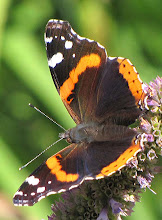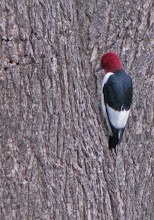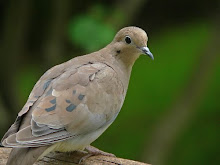The first week in August and my garden is winding down. The daylilies are almost finished with their dramatic display.
This golden daylily performed exceptionally this season. Fully eight inches across with a wonderfully rich color. One of the first to bloom and still many buds left to guarantee it will be one of the last to finally finish.

Double red, Moses' Fire, began blooming late so it still has buds left to bloom.

This yellow was a free gift from Wilds when I ordered Mose's Fire. A buttery color and a heavy, crinkled texture. It was late to began blooming and still has a weeks worth of buds to spend.

Late season clematis looking down from their bird house crook.
Mrs Wren brings home the bacon. Constant screams of "Feed me" echo from the house.

Mr Wren sits on his shepherds crook and sings. Occasionally he pauses and scolds me for trespassing in his garden. His life seems less strenuous than his wife's.

Stargazers in full bloom. Sweet lily fragrance hanging in the still evening air as I snap photos.

Coneflowers finally doing what nature intended. The first monarch to visit the garden this season.

A small daylily with a lemony, translucent flower and a very long bloom time rivaling the Stellas.

Another Moses' Fire. The reds are unpredictable. Wonderful, fiery color some days but dull and drab others. Today Moses was having a good day.

Sunflowers pop up in unlikely places. Who doesn't smile when passing a sunflower?

This ruinous garden an old woman made
And fertilized with tea leaves and coffee grounds,
Is wild grass mostly, climbed up to the thigh;
The multitude of dandelion surrounds
Enclaves of iris and peony;
While at the wall, the handle of a spade
Is thoroughly fastened in a climbing vine
That has crawled among blue flowers serpentine.
~Howard Nemerov
Hoping you all have a sunny weekend and I"ll be back Monday.

Stargazers in full bloom. Sweet lily fragrance hanging in the still evening air as I snap photos.

Coneflowers finally doing what nature intended. The first monarch to visit the garden this season.

A small daylily with a lemony, translucent flower and a very long bloom time rivaling the Stellas.

Another Moses' Fire. The reds are unpredictable. Wonderful, fiery color some days but dull and drab others. Today Moses was having a good day.

Sunflowers pop up in unlikely places. Who doesn't smile when passing a sunflower?

This ruinous garden an old woman made
And fertilized with tea leaves and coffee grounds,
Is wild grass mostly, climbed up to the thigh;
The multitude of dandelion surrounds
Enclaves of iris and peony;
While at the wall, the handle of a spade
Is thoroughly fastened in a climbing vine
That has crawled among blue flowers serpentine.
~Howard Nemerov
Hoping you all have a sunny weekend and I"ll be back Monday.




























































































































